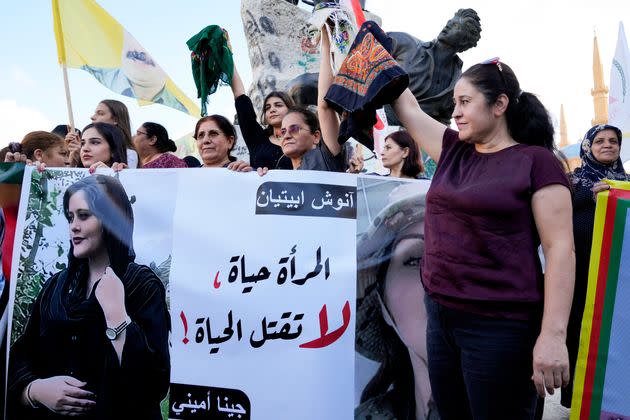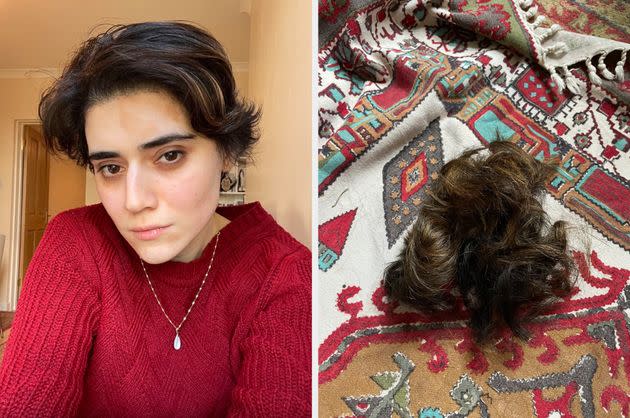'Woman, Life, Freedom': Why We're Cutting Our Hair To Support Protesters In Iran

Kurdish activists in Beiruit hold headscarfs and a portrait of Iranian woman Mahsa Amini, with a sign reading: 'The woman is life, don't kill the life,' during against her death. (Photo: via Associated Press)
When Soutiam Goodarzi, a 20-year-old from Leeds, saw videos of women in Iran burning hijabs and cutting their hair, she knew she wanted to do the same.
Goodarzi was born in Iran and lived there until she was nine. Now a student at the University of Oxford, she describes the recent protests in Iran – sparked by the death of 22-year-old Mahsa Amini, who was arrested for breaking hijab laws – as “very close to my heart”.
“I cut my hair as a mark of solidarity with women living in Iran,” she tells HuffPost UK. “And to draw attention to the protests, especially since internet access is restricted in Iran”.
Goodarzi is one of thousands of women around the world who’ve hacked away at their locks as a symbol of protest, solidarity and mourning.
On September 13, Mahsa Amini was arrested by Iran’s so-called “morality police” in Tehran for the way she was wearing her headscarf. Three days later, she died.
Her death came on the back of increasing reports from Iran of women facing repression over how they dress, including some saying officials banned them from entering government buildings and banks if they weren’t dressed according to the Islamic code.
Now, women in Iran are setting fire to their hijabs and chopping off their hair to protest for their rights, sparking some of the biggest protests the country’s seen in years.
This picture of chopped hair hoisted as a flag will be the photograph of this century.#IranProtests2022pic.twitter.com/pq1viygnvF
— Leena Manimekalai (@LeenaManimekali) September 22, 2022
The protests across the country, with many using the chant, “Woman! Life! Freedom!”, have seen riot police reacting with pellet guns and water canons. At least nine people had died as of Friday, September 23.
The government has also imposed an internet shutdown, not only preventing Iranians from speaking to each other through popular social media messaging apps, but also clamping down on information about the protests reaching the world at large.
Still, the movement has spread across the globe, with women of all ages filming themselves cutting their hair.
I decided to cut my hair to show solidarity with women in Iran. We need to keep raising awareness to the protests, especially given Iranians living in Iran have restricted access to the internet.#مهسا_امینی#ارتش_به_میدان_بیاpic.twitter.com/LR7801xhHk
— soutiam (@Souts_A) September 22, 2022
What sparked the protests?
On September 13, a 22-year-old woman named Mahsa Amini was arrested by Iranian morality police for wearing her headscarf too loosely while visiting the Iranian capital city of Tehran.
Iran has strict laws requiring women to wear hijab – a headscarf and loose clothing that covers their limbs. On Friday September 16, Amini died in a hospital after being in a coma for three days.
While the police claim she died of sudden heart failure, her family have insisted she had no history of health issues and suspect that she was beaten.
The first protests broke out at Amini’s funeral in her hometown in Kurdistan, where women – enraged by Amini’s death in police custody – started taking off their hijabs in protest of the regime’s strict hijab laws.
At Mahsa Amini's funeral in her hometown of Saqqez, Kurdistan province, women take their headscarves off in protest against Iran's forced hijab law amid "death to the dictator" chants.
Mahsa, 22, died in custody after being arrested by morality police.pic.twitter.com/MaqyberjNO— Shayan Sardarizadeh (@Shayan86) September 17, 2022
Since then, the protests have both expanded and escalated. Many more people, including men, have taken to the streets across at least 15 cities to express their support for women’s rights as well as their discontent with the Iranian government with shouts of “down with the dictator!” and “death to Khomeini” (Supreme Leader) being heard across the country.
The government has responded with violent suppression. Video footage from Twitter users show riot police using water canons on protestors in several places, including central Tehran.
In other videos, the sound of gunshots is audible on chaotic streets as protestors throw stones at riot police and get fired at with pellet guns.
Women who started off by taking off their hijabs to protest the strict laws are now publicly burning them.
Some cities have also seen pro-regime protests, with hijab-wearing women carrying signs saying: “We are obedient to the leader.”
This is Iran today. A woman proudly burning the most visible symbol of religious dictatorship; compulsory hijab.
Hijab police killed #MahsaAmini but now there are millions of Mahsa in Iran who are shouting NO to Forced hijab NO to gender apartheid regime.#مهسا_امینیpic.twitter.com/9tzd9IRwgB— Masih Alinejad 🏳️ (@AlinejadMasih) September 19, 2022
What’s happening in the UK?
Protests and vigils in support of women in Iran have spread across the world, and the UK is no exception. So far, there have been demonstrations in Birmingham and London, with more expected in the coming days.
Solidarity for all women in Iran from Birmingham #MahsaAminipic.twitter.com/4jXxiHuKdh
— Andy Moody🇺🇦 (@1418filmandy) September 22, 2022
This person and a few others shaved/cut their hair in solidarity with the people in Iran being murdered from protesting against the regime and women who are killed everyday for showing their hair. The song is also v emotional and meaningful my heart broke as ppl around me sobbed pic.twitter.com/6uCCSOGhix
— آریانا (@aryanna__v) September 21, 2022
Today in London, protest in solidarity with #Iranpic.twitter.com/RVc9ISyvkS
— Roberto Tovar (@robe_tovar) September 22, 2022
Women based in the UK have also been cutting their hair to show solidarity.
Somayeh Tohidi, a 34-year-old PhD student at the London School of Economics and Political Science, moved to the UK when she was 22. She decided to join in the online protests by cutting her hair – “a symbolic act of mourning in my culture” – even though she believes this could make travelling back to Iran difficult.
“Although I don’t wear a headscarf, I still identify as religious and I [am] explicit about this aspect of my identity on social media. I thought by cutting my hair and posting a video on social media I would declare that you can be religious and anti-government in Iran,” she tells HuffPost UK.
“I knew that by posting this, travelling to Iran would become risky for me. But I thought this is the least sacrifice that I can make.“Watching the news from Iran unfold from the UK has been difficult, and it has solidified Tohidi’s belief that the current system in her home country “is not reformable”.
“I’ve always been afraid of the idea of revolution, because I was afraid of civil war,” she says. “But now I believe enough is enough.”

Somayeh Tohidi (Photo: Somayeh Tohidi)
Now, women’s rights groups are calling for more Brits to support those in Iran, while also respecting a woman’s right to choose to wear a hijab in this country, or any other.
"Say her name: Mahsa." Dozens of people in Picadilly Circus, London, gather to demand justice for the murder of activist Mahsa Amini in Iran, brutally beaten by Morality police for not wearing the hijab "properly" #MahsaAmini#IranProtestspic.twitter.com/iru8tHhnfH
— Almudena Barragán (@Muna_bargan) September 21, 2022
Comedian Shaparak Khorsandi, who is vice president at Humanists UK, was born to non-religious parents in Iran and forced to flee to the UK with her family as a child to gain asylum. She says “the Iranian regime kills women for trying to live freely”.
“This is not just Iran’s problem, it is the world’s problem,” she tells HuffPost UK. “Do not look away. This denial of basic human rights is an affront to human dignity.”
If women in the UK want to support those in Iran, Khorsandi recommends “keeping this in the news [and] going to protests and awareness gigs”.
She is in the process of organising a comedy gig herself. She adds that our government “needs to get robust with the Iran regime”, and suggests people lobby their local MP on the cause.
“Mahsa Amini cannot speak up any more. The world should act in solidarity and amplify her voice and the voices of all Iranian women who dare to speak up for choice and democracy,” she says.
Nazmin Akthar, co-chair of the women’s rights group Muslim Women’s Network UK, warns the footage coming from Iran may be particularly difficult watching for some Muslim women.
“Whilst it may be understandably distressing for some Muslim women to see images of a hijab being burnt if they hold it as a key aspect of their faith and religiosity, we would encourage them to understand the context of the protests,” she says.
“Just as Muslim women have the right to choose to wear a hijab, equally Muslim women should have the freedom to exercise their right to not to wear one, without fear of punishment. No person or state should be dictating to Muslim women how to dress and we feel this is something the vast majority of Muslim women can agree on.”
Akthar says those working for Muslim Women’s Network (MWN) “commend the bravery of the women and men in Iran who are protesting because they are putting their lives at risk for the human rights of all”.
For Muslim women affected by the events, she says the MWN Helpline is available for support and advice.
Though the protests were sparked by tragedy, student Soutiam Goodarzi says the global response is a reason for hope.
“As for how I feel, I have to say angry and hopeful. Angry at the regime for killing an innocent woman. Angry at the regime for murdering protesters. But I am hopeful,” she says.
“There is a chance that things will finally turn around in Iran. That the people of Iran will finally be liberated. That they would no longer have to live under a regime where showing a bit of your hair comes with a possibility that you may lose your life.”
This article originally appeared on HuffPost UK and has been updated.

